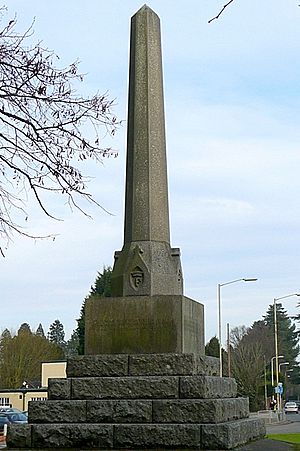Great Tew Circle facts for kids
The Great Tew Circle was a group of important thinkers, writers, and religious leaders who met in the 1630s. They gathered at a large country house called Great Tew in Oxfordshire, England, and also in London.
This group was led by Lucius Cary, who became the 2nd Viscount Falkland in 1633. The house belonged to his noble family. One of the most famous members was Edward Hyde. He later became a well-known statesman and historian. Lord Clarendon described the Circle as "A college situate in a purer air." This meant they sought truth away from the strong disagreements of the time.
Contents
Ideas and Beliefs
During a time of many religious arguments, the Great Tew Circle had some different ideas. They were open to views like Socinianism, which focused on reason and tolerance in religion. They also favored "Arminian humanism," which was a more flexible approach to faith. This was different from the very strict Calvinism of the time. Their religious ideas often matched their political views, which supported the king (known as royalist views).
A key religious thinker in the group was William Chillingworth. Lord Falkland's mother, Elizabeth Cary, Lady Falkland, had become a Catholic. This might have made Falkland more open to different religious ideas. He liked the tolerant approach of the famous scholar Erasmus. Falkland organized the Circle with his wife, Lettice.
Key Influences
The thinkers in the Great Tew Circle were inspired by several important writers. These included Hugo Grotius and Richard Hooker. Hooker was important because he believed in using reason to understand the Bible and how the church should be organized.
These writers were part of a wider tradition of Christian humanism. This tradition included people like Jacobus Acontius, George Cassander, and Sebastian Castellio. The Circle also valued the ideas of Jean Daillé, who questioned some older church writings.
According to Edward Hyde, the discussions in the Circle were like those held by ancient Roman thinkers such as Cicero, or by Erasmus. Guests were encouraged to share different opinions. They even had philosophical or theological discussions during dinner, which Hyde compared to Erasmus's "godly feast."
Tolerance and Open-Mindedness
The Great Tew Circle was very interested in religious toleration, which means accepting different religious beliefs. They believed in peaceful discussion and finding common ground. This was especially important during the Thirty Years' War, a period of intense religious conflict in Europe.
William Chillingworth was influenced by Acontius, and the Circle studied Acontius alongside Johannes Crellius, a Socinian thinker. They found Acontius's focus on peace (called eirenicism) more useful than the specific theology of Socinus.
Historian Hugh Trevor-Roper said the Great Tew group stood for religious tolerance and rational discussion. They wanted to deal with the growing skepticism about religious matters. The Circle found that using probabilism (a way of thinking about what is likely true) helped them address skepticism.
The main religious thinkers of the Circle, like Chillingworth and John Hales, are often seen as early examples of the Latitudinarians. This group, which became more common later, believed that not all religious beliefs were equally important. They also helped prepare the way for the Cambridge Platonists, another group of thinkers who believed in reason and tolerance in religion.
Who Was Involved?
It's hard to know exactly who participated in every discussion at Great Tew. The group was active from about 1634 until around 1640, when political problems became too big for quiet discussions. The Circle's influence can be seen in important religious books, literary works, and the political actions of Falkland and Hyde. They tried to find a middle ground between extreme religious and political groups.

Here are some of the people mentioned as being part of Falkland's Circle:
- Churchmen
- William Chillingworth
- John Earle
- John Hales
- Henry Hammond
- Jeremy Taylor
- Writers
- Thomas Carew
- Abraham Cowley
- Sidney Godolphin
- George Sandys
- Sir John Suckling
- Edmund Waller
- Politicians and Lawyers
- Dudley Digges
- Edward Hyde
- John Selden
Other Connections
Great Tew was known for being open to scholars from Oxford. Falkland also had many contacts in London and at the royal court. So, some people were connected to the Circle even if they didn't live at Great Tew.
- Thomas Hobbes: It's not clear if Hobbes visited Great Tew, but he was friends with members of the Circle in London.
- Poets: Ben Jonson was friends with members and visited Great Tew.
- Katherine Jones, Viscountess Ranelagh: She moved to England from Ireland and was connected to the Circle.
- Izaak Walton: He wrote biographies of some members, showing his close ties to the group.
Links to Other Groups

Falkland himself was part of the "Tribe of Ben," a group of writers who admired Ben Jonson. Other members of the Great Tew Circle were also in this group.
Some historians have linked Hales and William Chillingworth to an "Oxford School of rational theology." This group believed in using reason in religious discussions.
Katherine Jones was connected to both the Great Tew Circle and the Hartlib Circle, another group of thinkers.
After her husband died, Lady Falkland (Lettice) took in John Duncon, a clergyman who had lost his church during the English Civil War. He later wrote her biography. It has been suggested that her household was run in a similar way to the Little Gidding community, a religious community known for its strict but loving way of life.


